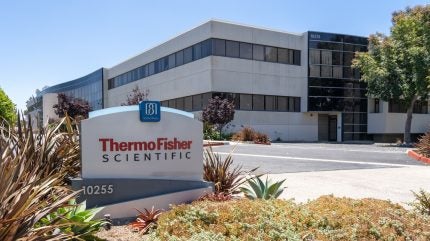
Thermo Fisher has outlaid $2bn to expand manufacturing and development in the US, joining the long list of companies directing resources to domestic operations as ongoing US tariffs risk destabilising global trade.
The life sciences giant, which provides products and services to biopharma companies manufacturing drugs, said the $2bn will be invested over the next four years.
Thermo Fisher said $1.5bn in capital expenditure would go towards enhancing and expanding US manufacturing operations, whilst the remaining $500m would be directed towards research & development (R&D).
There are 64 manufacturing sites operated by Thermo Fisher in the US that provide contract development and manufacturing services for pharmaceutical innovators. Facilities also make analytical instruments, specialty diagnostics and other solutions in the life sciences space.
Thermo Fisher did not immediately respond to Pharmaceutical Technology on whether existing sites would benefit from the investment or whether new facilities would be developed over the coming years.
Efforts to shore up US manufacturing capabilities come at a time when tariffs announced by US President Donald Trump have made importing into the country less attractive. The government has also threatened tariffs on pharmaceutical imports, an area that previously escaped the blanket levies.

US Tariffs are shifting - will you react or anticipate?
Don’t let policy changes catch you off guard. Stay proactive with real-time data and expert analysis.
By GlobalDataThe $2bn is a commitment by Thermo Fisher to US manufacturing amid the volatile international trade channels. “[It] reflects our confidence that America will continue to lead the world in science and innovation,” Thermo Fisher’s CEO Marc Casper said.
“By expanding our US operations, we ensure that life-saving medicines and therapies will continue to be developed and produced in America for decades to come,” he added.
The US expansion is set to counteract headwinds in business operations reported in its Q1 earnings, on 23 April. Thermo Fisher estimates a $400m hit to its sales of products in China this year. Revenue in the country accounts for around 8% of its business.
Wall Street was unmoved despite the shaky outlook, with shares in the NYSE-listed company being down by only 0.4% when the markets opened on 24 April following the Q1 earnings report on the previous day. Investor caution was potentially tempered by the $2bn earmarked for US operations.
In a Q1 earnings call, chief financial officer Stephen Williamson said sales of the company’s US-manufactured products in China would be affected by the ongoing trade disputes. Likewise, the cost of parts manufactured in China, which Thermo Fisher relies on for assembly, would be affected by tariffs. Intuitive Surgical, developer surgical robotic systems, revealed similar impacts in its Q1 report.
Thermo Fisher is one of many companies redirecting resources to the US in an effort to make supply chains more robust. Earlier this week, Roche unveiled a $50bn investment strategy to upgrade three R&D sites in the US. Novartis, Johnson & Johnson and Eli Lilly have also made similar investment announcements.
The current investment by Thermo Fisher follows $4.1bn spent by the company in February 2025 to acquire Solventum’s purification & filtration business unit that has a global footprint, including sites in North America. Not all of Thermo Fisher’s US sites have enjoyed investment recently. The company continued its strategic withdrawal from the viral vector manufacturing space in February, cutting headcount at two of its US facilities by 300. Weaker demand for drug manufacturing in recent years has led to several other cost-cutting initiatives, including redundancies at its plasmid manufacturing site in California, the closure of its biologics development and cell therapy services facility in New Jersey, and gene therapy facilities in Florida.
Navigate the shifting tariff landscape with real-time data and market-leading analysis.
Request a free demo for GlobalData’s Strategic Intelligence here.




